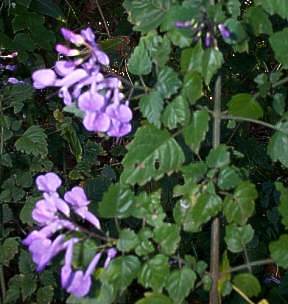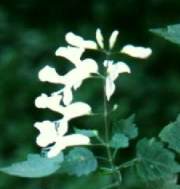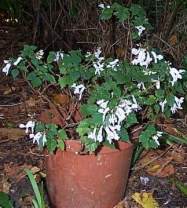Plectranthus saccatus
Plectranthus saccatus Benth.
Family: Lamiaceae
Common names: stoep jacaranda, porch jacaranda (Eng.); stoepjakaranda, sak-spoorsalie (Afr.)
Introduction
This is one of the more popular and well-known of the Plectranthus or spurflowers. It is known for its pretty flowers which are larger than those of most other plectranthus.

Description
Description
Plectranthus saccatus is a soft, semi-succulent shrub with a woody base. The branches are tinged with purple and have soft hairs. The leaves are bright green, have large teeth along the margin and are dotted with transparent gland dots beneath. The shrub reaches a height of about 1.2 m. The flowers may have some purple markings and are borne on one side of the stem. Flowering occurs in summer to autumn (from November to May).
The large petals distinguish the stoep jacaranda from others in the genus. The flowers bear a vague resemblance to the Jacaranda mimosifolia flower, hence the common name (though it is no relation to the jacaranda). The colour of the flowers is also similar to those of the jacaranda and ranges from blue to lilac and sometimes white. Since it is a shade-loving plant, it is often used as a stoep (porch) plant. There are a number of different varieties and cultivars of this plant.

Plectranthus saccatus belongs to the sage or mint family (Lamiaceae) which has a very large representation in the Mediterranean regions. The family is characterised by aromatic leaves arranged in opposite pairs (decussate) and the two-lipped corolla.
Distribution and habitat
Distribution description
Plectranthus saccatus is found naturally in the Eastern Cape and KwaZulu-Natal growing in forests. It also grows in semi-shade and in rocky areas.
Derivation of name and historical aspects
History
The genus name Plectranthus means 'spur flower' after the spurred corolla tube which is a characteristic of the species. The species name saccatus means 'bag-like' and refers to the shape of the flower tube.
Growing Plectranthus saccatus
Grow
This plant is very easy to propagate from cuttings, even in a glass on the window-sill! Take softwood cuttings from the tips of healthy plants. They dry out quickly so be careful to keep them moist until you are ready to put them into trays. Work in the shade on a clean surface. Root cuttings in sand or well drained medium to prevent rotting, but do not allow to dry out. No rooting hormone will be required.

The stoep jacaranda is sensitive to frost. However, because it likes a shady position it is usually protected from the worst of the frost and the cold winds. Fortunately flowering has usually finished by the time the first frosts appear. In early spring the shrubs may be cut back to keep them neat and bushy. It is suitable for mass plantings, especially if you mix the white and blue forms. It also makes a lovely container plant for a shady spot.
References
- Codd, L.E. 1985. Flora of Southern Africa. 28:4. Botanical Research Institute. Pretoria
- Joffe, P. 1993. The Gardener's Guide to South African Plants. Delos. Cape Town
- Joffe, P. 2001. Creative Gardening with Indigenous Plants: A South African Guide. Briza. Pretoria.
- Pooley, E. 1998. A Field Guide to Wild Flowers of KwaZulu-Natal and the Eastern Region. Natal Flora Publications Trust. Durban.
Credits
L. Mashinini and A. Aubrey
Witwatersrand National Botanical Garden
March 2002
Plant Attributes:
Plant Type: Perennial, Scrambler, Shrub
SA Distribution: Eastern Cape, KwaZulu-Natal
Soil type: Sandy, Loam
Flowering season: Early Summer, Late Summer, Autumn
PH: Neutral
Flower colour: Blue, White, Mauve/Lilac
Aspect: Shade, Morning Sun (Semi Shade), Afternoon Sun (Semi Shade)
Gardening skill: Easy
Special Features:
Horticultural zones









Rate this article
Article well written and informative
Rate this plant
Is this an interesting plant?
Login to add your Comment
Back to topNot registered yet? Click here to register.